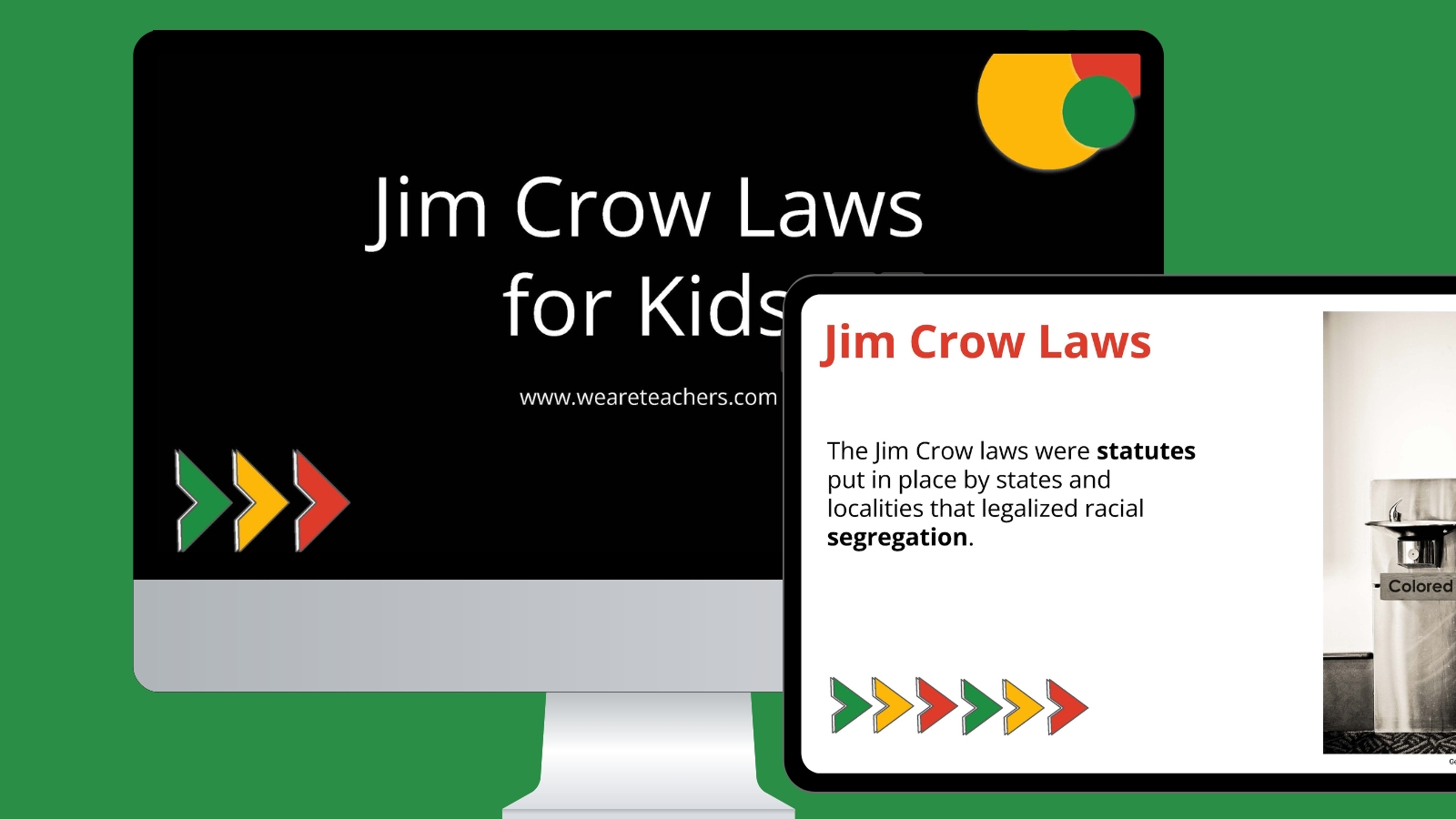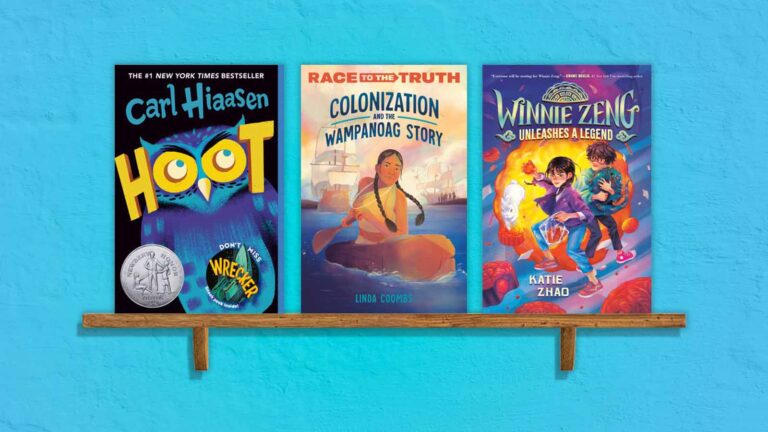Talking about the Jim Crow laws era with kids can be really tough. It was a dark time in American history, one that still has ramifications in today’s world. Use these resources to teach kids about Jim Crow laws, and remember that learning from our past mistakes is the best way to keep from repeating them.
Note: Jim Crow laws and the history of segregation are challenging, controversial, and emotionally charged topics. The information here provides a basic overview for students, but it barely scratches the surface of this incredibly important issue. Use the links throughout this text to get more information from a variety of trusted resources.
Want your free Google Slides? Enter your information here:
Jump to:
- Jim Crow Laws Facts for Kids
- Examples of Jim Crow Laws
- Jim Crow Laws Videos for Kids
- Children’s Books About Jim Crow Laws
- More Jim Crow Laws Teaching Resources
Jim Crow Laws Facts for Kids
What were Jim Crow laws?
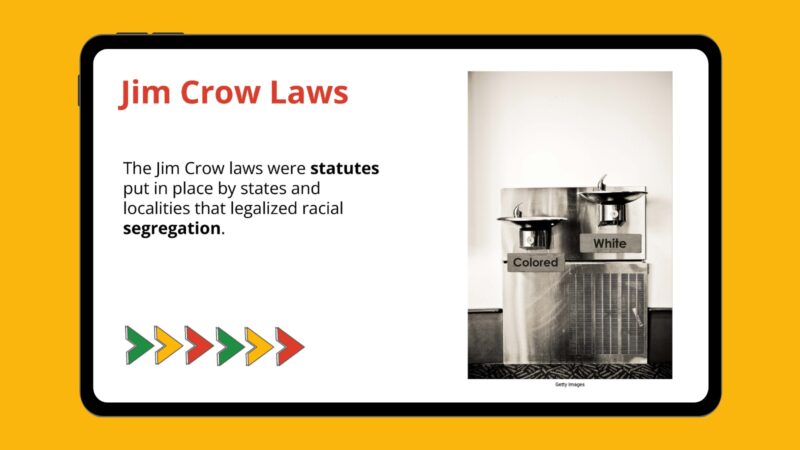
Jim Crow laws were statutes put in place by states and local areas that legalized racial segregation. In other words, these laws said that people of color weren’t allowed the same rights as white people. These laws were wide-ranging and aimed to keep white people and Black people separate, while stripping Black people of as any many rights as possible. Legally known as “Black Codes,” these laws were nicknamed Jim Crow laws. The name “Jim Crow” comes from an 1800s minstrel show called “Jump, Jim Crow” (see below).
What is segregation?
Segregation means separation. In legal terms, it meant that people of color were kept separate from white people and denied access to many facilities and opportunities. For instance, there were separate schools for white children and Black children in many communities.
After the 1896 Supreme Court case Plessy v. Ferguson, people often used the phrase “separate but equal” to justify segregation laws. They claimed that people of color received the same rights and benefits as white people, just in separate locations. In practice, separate was usually anything but equal. Black communities and schools received less funding, and people weren’t allowed to move into better neighborhoods or attend better schools.
Who was Jim Crow?
Black minstrel shows were once very popular forms of entertainment. White performers would paint their faces black (“blackface”) and dress in shabby clothes like enslaved people might have worn. They then sang songs (especially Black spirituals) and told stereotypical jokes and stories they claimed were “inspired” by Black culture. (Blackface and minstrel shows are both considered highly offensive today.)
One popular act was called “Jump, Jim Crow.” It was so well known that “Jim Crow” became a derogatory name used to describe a Black person as early as the 1830s.
When did Jim Crow laws start?
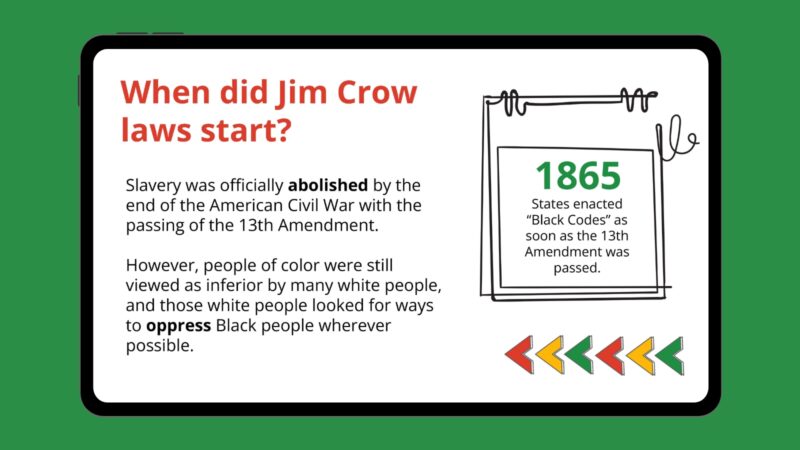
By the end of the American Civil War, slavery was officially abolished in every state in America. However, this didn’t change the way many white people felt about people of color. They still viewed them as “inferior” and looked for ways to oppress Black people wherever possible. Some states enacted segregation laws (Black Codes) as early as 1865, as soon as the 13th Amendment, which abolished slavery, was passed.
What was the purpose of Jim Crow laws?
After slavery was abolished, many white people felt threatened by the newly freed Black people. They still considered people of color inferior, saying they weren’t as smart, as capable, or even as moral as white people (despite overwhelming evidence to the contrary). They spread terrible rumors that free Black people would put white families in danger, and convinced their communities to pass laws (Black Codes) that would oppress people of color.
One of the major purposes of Jim Crow laws was to keep Black people from being able to vote. Voting is a powerful tool, one that drives change. By denying people of color access to the polls, white people could ensure they stayed in charge.
Jim Crow laws also aimed to keep white people separate from Black Americans. They required separate housing, schools, business, and even restrooms and drinking fountains. Overall, Black Codes were meant to ensure that white people could continue to dominate all areas of society.
Where were Jim Crow laws found?
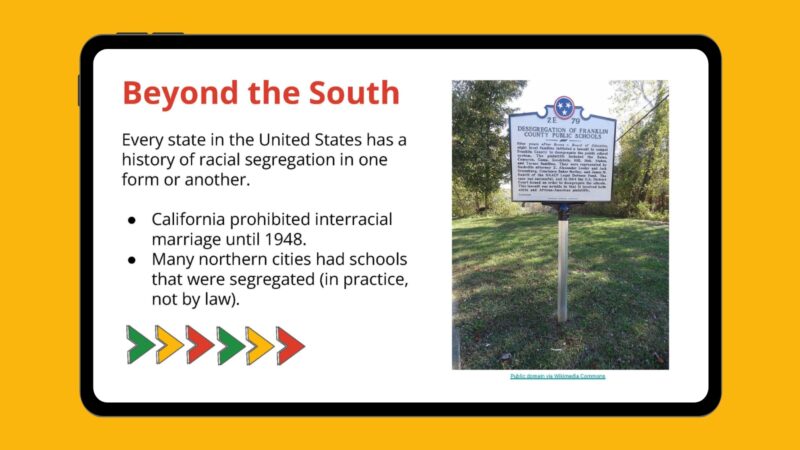
Black Codes were common throughout the former Confederate states of the South. Some were enacted at the state level, while many others were put in place by counties, cities, and other local areas.
However, Jim Crow laws and segregation weren’t limited to the South. California prohibited interracial marriage until 1948. Many northern cities had schools that were segregated in practice (if not by law), and efforts to integrate them through bussing were met with strong resistance from white members of the community. Every state in the United States has a history of racial segregation in one form or another.
What is Plessy v. Ferguson?

In 1868, the United States added the 14th amendment to the Constitution. In the wake of a wave of racial violence and discrimination following the Civil War, this amendment guaranteed equal civil and legal rights to Black citizens. After the spread of Black Codes during the following decades, politicians tried more ways to ensure people of color their rights. They passed the 1875 Civil Rights Act, making racial discrimination illegal, but the Supreme Court struck it down in 1883.
In 1891, a group of young Black men in New Orleans decided to challenge the state law that required railroads to provide separate cars for Black and white riders. They argued that the law requiring “separate but equal” accommodations was unconstitutional. By 1896, the Plessy v. Ferguson case made its way to the Supreme Court. The court ruled against the Black plaintiffs, making “separate but equal” laws permissible under the Constitution throughout the country.
When and how were Jim Crow laws abolished?
In the 1950s and 1960s, Black community leaders began a strong push (the Civil Rights Movement) to gain true equal rights for all Black Americans and other oppressed citizens. Through a series of local and national actions, they succeeded in overturning many Jim Crow Black Code laws. One major event was Brown v. Board of Education in 1954, which overturned the Plessy v. Ferguson ruling of over 50 years prior.
After years of struggles, marches, non-violent protests, and campaigning, the Civil Rights Act of 1964 became law. It prohibited discrimination and segregation in public places, ordered the integration of schools and other public facilities, and forbade housing and employment discrimination due to race. The era of Black Codes and Jim Crow laws was over, at least legally.
What is the legacy of Jim Crow laws?
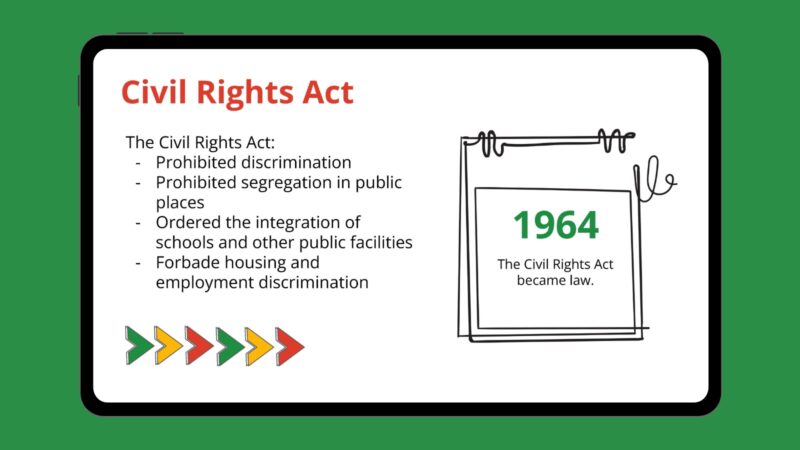
The 1964 Civil Rights Act was an incredibly important moment in America’s history, and in its wake, many people’s opinions and actions gradually changed for the better. But it’s wrong to assume that racism and prejudice ended with the abolishment of Black Codes and Jim Crow laws. The United States still struggles with these issues today, impacting people of color in a variety of ways. Many feel we must keep the conversation about civil rights, equality, and equity at the forefront of our nation’s consciousness, so we don’t revert to the days of legalized segregation and discrimination.
Examples of Jim Crow Laws
Black Codes, known informally as Jim Crow laws, aimed to suppress the rights of people of color and ensure white people continued to dominate society for nearly 100 years after the Civil War ended. Here are some common Jim Crow law examples.
Voting Rights
Denying Black citizens the right to vote made it easier for white people to stay in positions of power. Laws like these were common across the Southern states until the Voting Rights Act of 1965 overturned them.
- Literacy Tests: Since it was illegal to teach enslaved people to read, many of them were by default illiterate. Even those who could read were punished by these tests, since the poll clerks often had complete discretion over what it meant to pass or fail.
- Poll Taxes: Eleven states required a poll tax of $1 to $2 a year per citizen. This amount may not seem like much, but it was extremely difficult for many poor Black families to raise.
- White Primaries: Primary elections were run by political parties, not the federal government. These parties often limited primaries to white voters only, keeping Black candidates from gaining any popularity.
Education
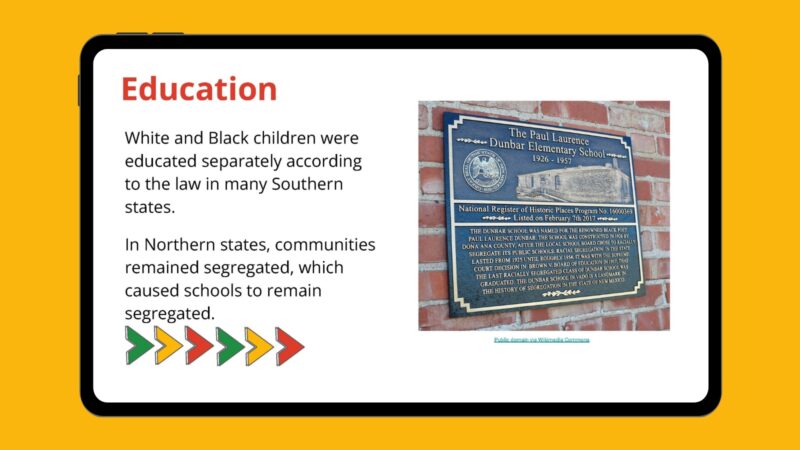
Nearly all Southern states and communities passed laws requiring white children and Black children to be educated separately. Many Northern communities had segregated schools because white people and people of color often lived in different neighborhoods.
Supposedly, these schools were “separate but equal.” In practice, Black communities were often poorer and less able to pay taxes to support their schools. At the federal level, legislators were less likely to grant funding to Black schools (sometimes called “Jim Crow Schools”), providing them with fewer resources. Ultimately, generation after generation of Black children received inferior educations and learning opportunities.
Employment
Many white people sought to keep Black people working only in jobs they considered “appropriate,” usually those that involved manual labor and low pay. For example:
- Mississippi required Black citizens to provide written proof of their employment for the year ahead each January. If Black citizens left those jobs before the end of the year, they could be forced to forfeit the wages they had earned and even be arrested.
- South Carolina fined people for working any job except as farmers or domestic servants.
To prevent Black citizens from moving north in search of better jobs, Southern states restricted interstate labor agencies from posting jobs or recruiting in predominantly Black communities. Even in the Northern states, some employers continued to hire based on race, keeping people of color in jobs that limited their advancement and wage opportunities.
Housing
Prior to the Civil Rights Act of 1964, people could choose not to rent or sell property to others based on their race. Banks could even deny mortgage loans to those living in certain areas (usually predominantly Black communities), a process called redlining. People believed that property values would drop if neighborhoods were integrated, a claim backed by the Federal Housing Administration.
Public Access
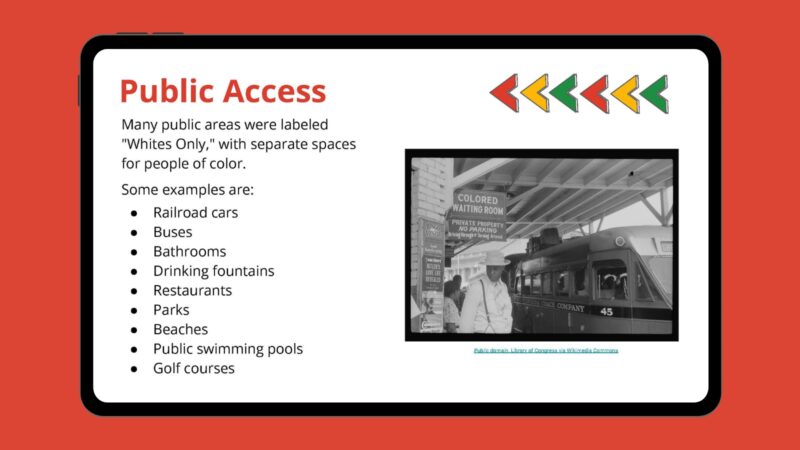
There were hundreds of other laws meant to keep white people separate from Black people. Many public areas were labeled “Whites Only,” with separate spaces for people of color. Some segregated places and facilities included (but weren’t limited to):
- Railroad cars
- Buses
- Bathrooms
- Drinking fountains
- Restaurants
- Parks
- Beaches
- Public swimming pools
- Golf courses
- Ticket windows
- Entry doors
- Waiting areas
- Doctors and hospitals
- Hotels and boarding houses
- Phone booths
- Prisons
- Libraries
- Stores
- Movie theaters
Videos for Kids About Jim Crow Laws
Did You Know? Jim Crow Laws
Encyclopedia Britannica produced this short video with an overview of Jim Crow laws. The real images from the time help bring the subject to life.
Jim Crow by Khan Academy
You can always count on Khan Academy to provide quality information, and this video series (there are four parts in total) is no exception.
60 Second Civics: Jim Crow Laws
The Center for Civics Education’s video is a quick look at this time, perfect for introducing the subject to your students.
What Was It Like Growing Up in Alabama Under Jim Crow?
When John Lewis questioned Jim Crow segregation laws during his childhood, his parents and grandparents told him, “That’s the way it is.” But for Lewis, that answer wasn’t good enough.
The Jim Crow Era: A Stain on America’s Past
If you’re looking for a longer documentary to share with older students, this might fit the bill. Starting with Plessy v. Ferguson, it outlines Jim Crow laws and their eventual overturn.
Jim Crow Laws Books for the Classroom
Ruth and the Green Book by Calvin Alexander Ramsey and Gwen Strauss, illustrated by Floyd Cooper
The Negro Motorist Green-Book helped Black motorists navigate travel around the USA during the Jim Crow laws era, knowing where it was safe to travel and places they should avoid. (Read the fascinating reproduction copy here.) In this picture book, a Black American family uses the book to enjoy their trip safely from Chicago to Alabama in the early 1950s.
Buy it: Ruth and the Green Book at Amazon
Freedom on the Menu by Carole Boston Weatherford, illustrated by Jerome Lagarrigue
Eight-year-old Connie is familiar with the signs around her town telling where she can and can’t go as a Black child. So she’s amazed to see four Black teens take a stand at a local lunch counter one day, soon sparking a wider civil rights movement right in front of her eyes.
Buy it: Freedom on the Menu at Amazon
Freedom Summer by Deborah Wiles, illustrated by Jerome Lagarrigue
The two boys in this story, one white and one Black, find their friendship impacted both by the Jim Crow laws that segregate their town pool and the end of those laws. Fortunately, these two find that friendship is stronger than hate and prejudice.
Buy it: Freedom Summer at Amazon
American Nightmare: The History of Jim Crow by Jerrold M. Packard
Older students who want a more complete look at Jim Crow laws in the United States should check out this thorough review of a century of legalized segregation. More than one reviewer says, “This should be a required reading for every American.”
Buy it: American Nightmare: The History of Jim Crow at Amazon
From Jim Crow to Civil Rights: The Supreme Court and the Struggle for Racial Equality by Michael J. Klarman
For a deep, in-depth dive into the Jim Crow and civil rights cases brought before the Supreme Court, add this book to your shelf. This one is best for those fascinated by legal history and the judicial system.
Buy it: From Jim Crow to Civil Rights at Amazon
Teaching and Learning Resources for Kids About Jim Crow Laws
- The Rise and Fall of Jim Crow (PBS): Find a big selection of videos and accompanying lessons plans for grades 9-12.
- Jim Crow Lesson Plan (iCivics): Use primary documents and images to learn more about the era.
- Segregation From Jim Crow to Linda Brown (Library of Congress): This in-depth lesson plan includes a weeklong project for students in grades 6-12.
- Jim Crow Museum Lesson Plans: Get a big list of resources on Jim Crow laws, African American achievement, slavery, civil rights, and more.
- Jim Crow (BrainPOP): Use these resources, including a video and interactive activities, to discuss this topic with elementary-age kids.
Get your free Jim Crow Laws Google Slides for Kids
Just click the button below to fill out the form and get instant access to free downloadable Jim Crow Laws Google Slides for Kids with all the information included above, including kid-friendly explanations, videos, links to resources, and more.
